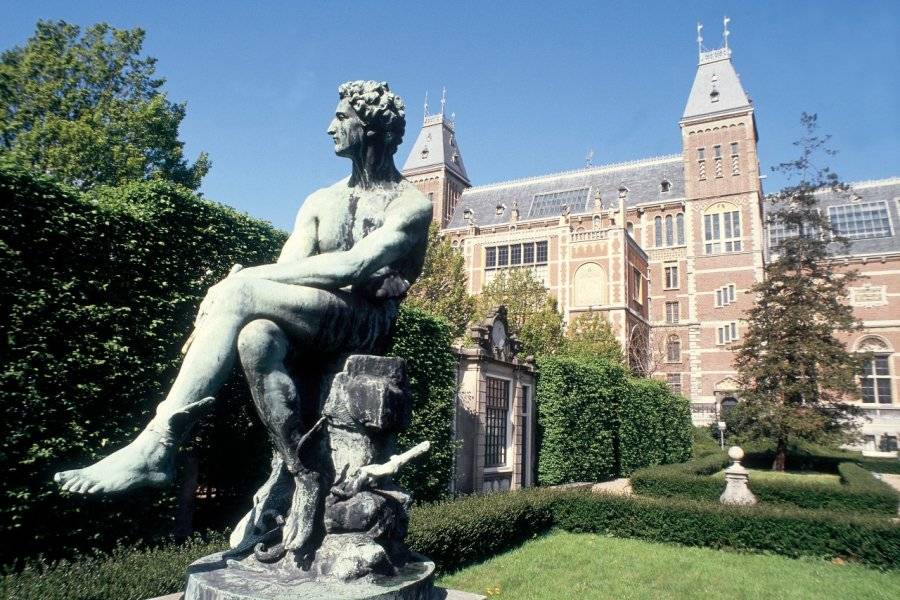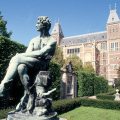Magnificent museum of the city, its visit is an enchantment. You will admire Rembrandt, Vermeer, Hals in a majestic setting.
A journey through beauty and time. After more than 10 years of laborious but since forgotten work, the Rijksmuseum (pronounced [Raïksmuséum]) reopened its doors in April 2013, inaugurated by Queen Beatrix in one of her last public appearances as sovereign. This museum alone justifies a visit to Amsterdam, and you should devote at least 4 hours to it, preferably an entire day. To guide you on your visit, we've put together an overview of the museum's not-to-be-missed highlights. With its new presentation, the Rijksmuseum is synonymous with a journey through the (artistic) history of the Netherlands, from the Middle Ages to the 20th century. This history unfolds in an international context and over 4 floors... Some say it's the real history museum of the Netherlands, and they're certainly not wrong... With over 8,000 paintings, drawings, prints, photographs, silverware, Delft porcelain, furniture and other objects, visitors to the Rijksmuseum experience beauty in a historical context. Its spectacular renovation, which has revealed ornate ceilings, is a thing of beauty and has further placed this museum on the world museum map, justifying a visit in its own right for both its collection and its exhibitions.
Middle Ages and Renaissance (1100-1600): Superb dark-walled rooms, featuring paintings and various objects, including Jan van Scorel, Maria Magdalena, circa 1530; Mater Dolorosa, circa 1500-1510; Les Pleurants, ten bronze figures.
The Golden Age (1600-1700) More than 30 rooms are devoted to this period of total development in the Netherlands. The highlight of this section is the Galerie d'Honneur, featuring works by Frans Hals, Jan Steen, Johannes Vermeer and Rembrandt. The final room is devoted to Rembrandt's Night Watch. Don't miss rembrandt van Rijn, The Night Watch, 1642; Rembrandt van Rijn, The Jewish Bride, c. 1665-1669; Johannes Vermeer, The Milkmaid, 1660; Johannes Vermeer, Woman in Blue Reading a Letter, c. 1663; Gerrit Berckheyde, The Golden Bend in the Herengracht, 1671; Jan Steen, The Mayor of Delft and his Daughter, 1655 ; Frans Hals, Portrait of Isaac Massa and Beatrix van der Laan, c. 1622 ; Doll's houses by Petronella Oortman, c. 1686-1710.
18thcentury (1700-1800). The Netherlands was no longer a strong nation, and the money earned was transformed into housing. In the 18th century, home interiors were of paramount importance. This period was characterized by refinement and the development of good taste. Don't miss: L' Amour menaçant, Étienne-Maurice Falconet (commissioned by Madame de Pompadour), 1757; De Beuningkamer, stylish mahogany room from a patrician house, 1748; Jean-Étienne Liotard, Portrait de Marie Fargues, 1765-1768.
19th century (1800-1900). The beginning of royalty and a period of major scientific discoveries, it is symbolized by great modernization. Not to be missed: Jan Willem Pieneman, Waterloo, 1824; Cassette with pistols of Napoleon, c. 1813-1815; Vincent van Gogh, Self-portrait, 1887; George Breitner, Girl with white kimono, 1894.
20thcentury (1900-2000). A totally new presentation for this century, with furniture, paintings, photographs, posters, films, historical objects and numerous loans from other museums, providing a portrait of the cultural and artistic history of the modern Netherlands in the last century. Not to be missed: Gerrit Rietveld, Fauteuil blanc, 1923; Piet Mondriaan, Trafalgar Square, 1942; Frits Koolhoven, Dubbeldekker F.K.23, named 'Bantam', 1917; Karel Appel, De vierkante man, 1951; Le Corbusier, Maquette du pavillon Philips, pour l'Exposition universelle de Bruxelles, 1958.
Asian arts. This collection is presented in a new pavilion designed by architects Cruz and Ortiz gemaakt all in concrete and surrounded by water. The two-storey building is a place of reflection, magic, beauty and wonder. A variety of objects from China, Japan, Indonesia, India, Vietnam and Thailand are on display. Objects (from 2000 BC to 2000) are presented by country.
The Cuypers Library. This is the oldest art library in the Netherlands, and has been extensively restored. The superb reading room is clearly visible and a must-see.
Special collections. The museum also boasts special collections of silverware, musical instruments, various relics, weapons and miniature boats, all presented in sublime fashion.
Miscellaneous collections, fashion, photos, drawings. The museum shows part of its very rich collection with a presentation that changes regularly. The costume display, for example, changes every six months.
A brief history of the Rijksmuseum. The Rijksmuseum opened its doors as a national gallery in 1800. At the time, it was located at the Huis ten Bosch in The Hague. Its collection consisted mainly of paintings and historical objects. The museum moved to Amsterdam in 1808, on Napoleon's orders, to the Royal Palace on Dam Square. Napoleon wanted Amsterdam to become a leading cultural and artistic center. In 1816, William I moved the museum to the Trippenhuis, a sort of Venetian palace built by two merchant brothers in the Kloveniersbugwal, and renamed it the Rijksmuseum. The current building opened in 1885, incorporating the collections of The Hague Museum of History and Art.
Cuypers' cathedral. The need for a truly national museum was felt, and construction began in 1876 after lengthy negotiations. The architect, Pierre Cuypers (1827-1921), created a brick building blending Gothic and Renaissance styles. The official inauguration took place on July 13, 1885. The collection brought together the paintings and prints of the Trippenhuis, as well as all the paintings of the city of Amsterdam, notably the famous Rembrandts. The 19th-century collection from Haarlem was added to the museum, as was a large part of the Cabinet of Curiosities, which had been integrated into the National Museum of History and Art.
Renovations. As the museum's collections grew ever larger, space was quickly at a premium, and expansion operations were carried out over the years. Between 1904 and 1916, rooms were added on the south side (now the Philips wing) to display the painting collections bequeathed by the Drucker-Fraser couple. Interior courtyards were added in the 1950s and 1960s to enlarge the display space. The 1950s also saw the birth of the Asian collection, following the integration of the collection of the Association des amis des arts asiatiques.
The 1970s saw a surge in visitor numbers, underlining the need for modern standards. This need was increasingly felt well into the 1990s, making renovations inevitable, which were completed (in full) in 2015, following the grand reopening of 2013.
In 2024, from February 16 to June 9, a major exhibition on Frans Hals will make the world sit up and take notice. And the Rijksmuseum is in full swing. This exhibition follows on from the Rembrandt events (2015 and 2019) and, above all, the Vermeer exhibition of the century in 2023. Around fifty works by Frans Hals from international collections will be presented. Frans Hals, with his liberated, impressionistic style, is considered by many to be one of the most innovative painters of the 17thcentury . His paintings of smiling children, musicians and notables are so talented that they seem to breathe the life of their subjects! This exhibition is organized in cooperation with a number of world-renowned museums, including London's National Gallery. Get your tickets as soon as possible.
Until June 16, 2024, an exhibition dedicated to lingerie from the 17th to the 20th century covers its evolution from 1640 to around 1940. Initially functional, lingerie became a fashion statement over the years.
Members' reviews on RIJKSMUSEUM














Daarna een lekkere "afterdrink" in het restaurant met een heel vriendelijke staf!
Kortom, 5 sterren!